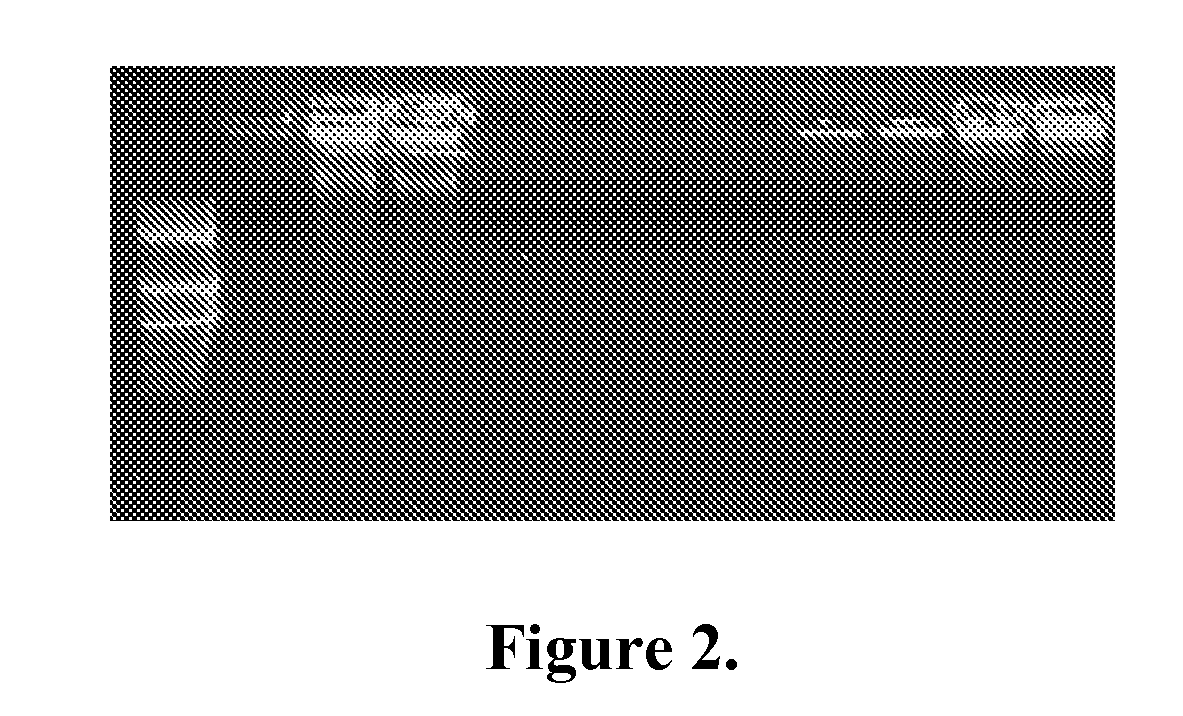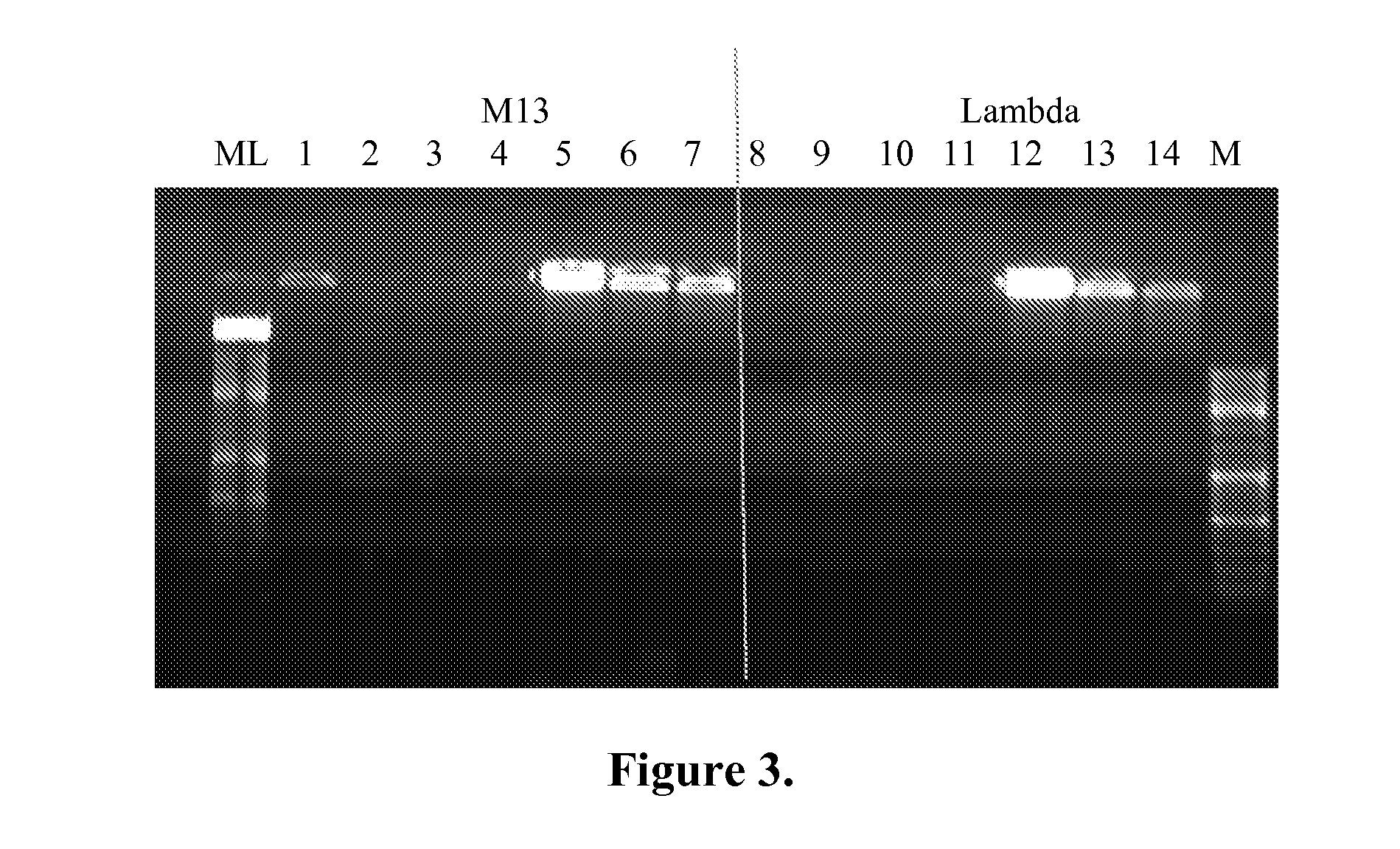Nucleic acid amplification
- Summary
- Abstract
- Description
- Claims
- Application Information
AI Technical Summary
Benefits of technology
Problems solved by technology
Method used
Image
Examples
example 1
Cloning of Tpol Polymerase and ORF904 Primase Fragment
An exemplary polymerase suitable for use in the present invention is pol-11 (Tpol) isolated from a Thermus species by Hjorleifsdottir, et al. (U.S. patent application Ser. No. 11 / 662,879, the disclosure of which is hereby incorporated by reference). This enzyme is moderately thermostable, has a very high specific activity, 3′ exonuclease activity, and strand-displacement activity. This enzyme has been used for WGA using random primers (U.S. patent application Ser. No. 11 / 662,879). A codon-optimized gene for Tpol (SEQ ID NO: 1) was synthesized by GeneArt and cloned into our expression vector pKB. The amino acid sequence of the coding region of the expression construct is given in SEQ ID NO: 2.
Nucleotide Sequence of Tpol (SEQ ID NO: 1):1ATGGCTAGCG CCGAAGGTTT TGAACTGCAT TATATTCCGG AAGTTGGTCC GGGTATGGGT61GAACTGCTGG ATCTGCTGAT GCGTCAGCCG GTTCTGGGTG TTGATCTGGA AACCACCGGT121CTGGATCCGC ATACCAGCCG TCCGCGTCTG CTGTCTCTGG CCATGCCTGG TGCAGTTG...
example 2
DNA Amplification with ORF904 Primase and Taq or Tpol Polymerase
Whole-genome amplification was performed in 25 μl reactions containing: 20 mM Tris-HCl pH 8.8, 10 mM (NH4)2SO4, 1.5 mM MgCl2, 10 mM KCl, 2 mM MgSO4, 0.1% Triton X-100, 0.2 mM dNTPs, 1 mM ATP and 180 ng M13mp18 ssDNA. 34 ng, 3.4 ng of ORF904 primase or 3 pmol of primer M13mp18-R (SEQ ID NO: 5) was added to the reactions together with 0.1 U of KapaTaq (KapaBiosystems) or 5 ng or 0.5 ng of Tpol. The samples were incubated for 60 minutes at 50° C. and 15 μl were run on an agarose gel (FIG. 1).
Oligo M13mp18-R (SEQ ID NO: 5):AACGCCAGGGTTTTCCCAGTCACGACGTTGTAAAACGACG
The results show that in the absence of primer or primase there is little or no amplification by both Taq and Tpol polymerases. The bands similar in size to the largest band of the marker are template bands. The addition of primase or a primer results in a large increase in amplification seen as high molecular weight bands or smears. Tpol in particular yielded high ...
example 3
Phi29 Polymerase with ORF904 Primase
Phi29 DNA polymerase is characterized by high fidelity, processivity and strand-displacement activity. We used Phi29 polymerase together with ORF904 to amplify DNA without adding primers to the reactions. Whole-genome amplification was performed in 25 μl reactions containing 37 mM Tris-HCl, pH 8.0; 50 mM KCl, 10 mM MgCl2, 5 mM (NH4)2SO4, 1.0 mM dNTPs, 0.025 U yeast pyrophosphatase (Fermentas), 0.6× SYBR green (Roche), 1 mM ATP, 0.1 mM DTT and 15 ng M13 ssDNA. 100 ng Phi29 (Fermentas), ORF904 primase and / or random hexamers were added. The reactions were incubated at 30° C. in a RotorGene cycler (Corbett Life Science) for 200 cycles of 30 seconds with data acquisition after each cycle. The results show that amplification was achieved in the presence of Phi29 and random hexamers and with Phi29 and primase (FIG. 2). Very little amplification or no amplification was observed in the absence of primers, primase (lane 1) or polymerase (lanes 4-7). Adding ...
PUM
| Property | Measurement | Unit |
|---|---|---|
| Temperature | aaaaa | aaaaa |
| Displacement | aaaaa | aaaaa |
Abstract
Description
Claims
Application Information
 Login to View More
Login to View More - R&D
- Intellectual Property
- Life Sciences
- Materials
- Tech Scout
- Unparalleled Data Quality
- Higher Quality Content
- 60% Fewer Hallucinations
Browse by: Latest US Patents, China's latest patents, Technical Efficacy Thesaurus, Application Domain, Technology Topic, Popular Technical Reports.
© 2025 PatSnap. All rights reserved.Legal|Privacy policy|Modern Slavery Act Transparency Statement|Sitemap|About US| Contact US: help@patsnap.com



